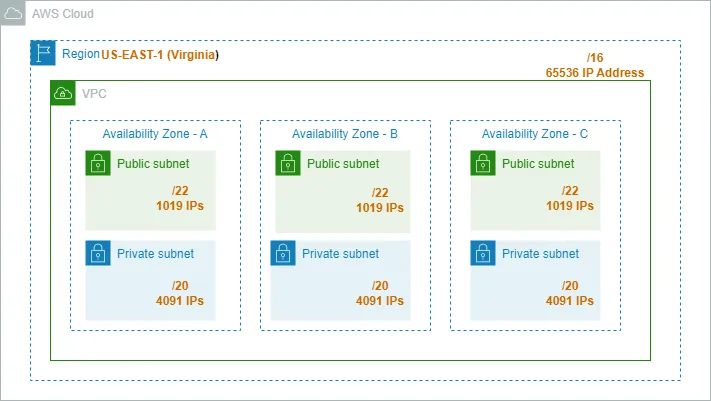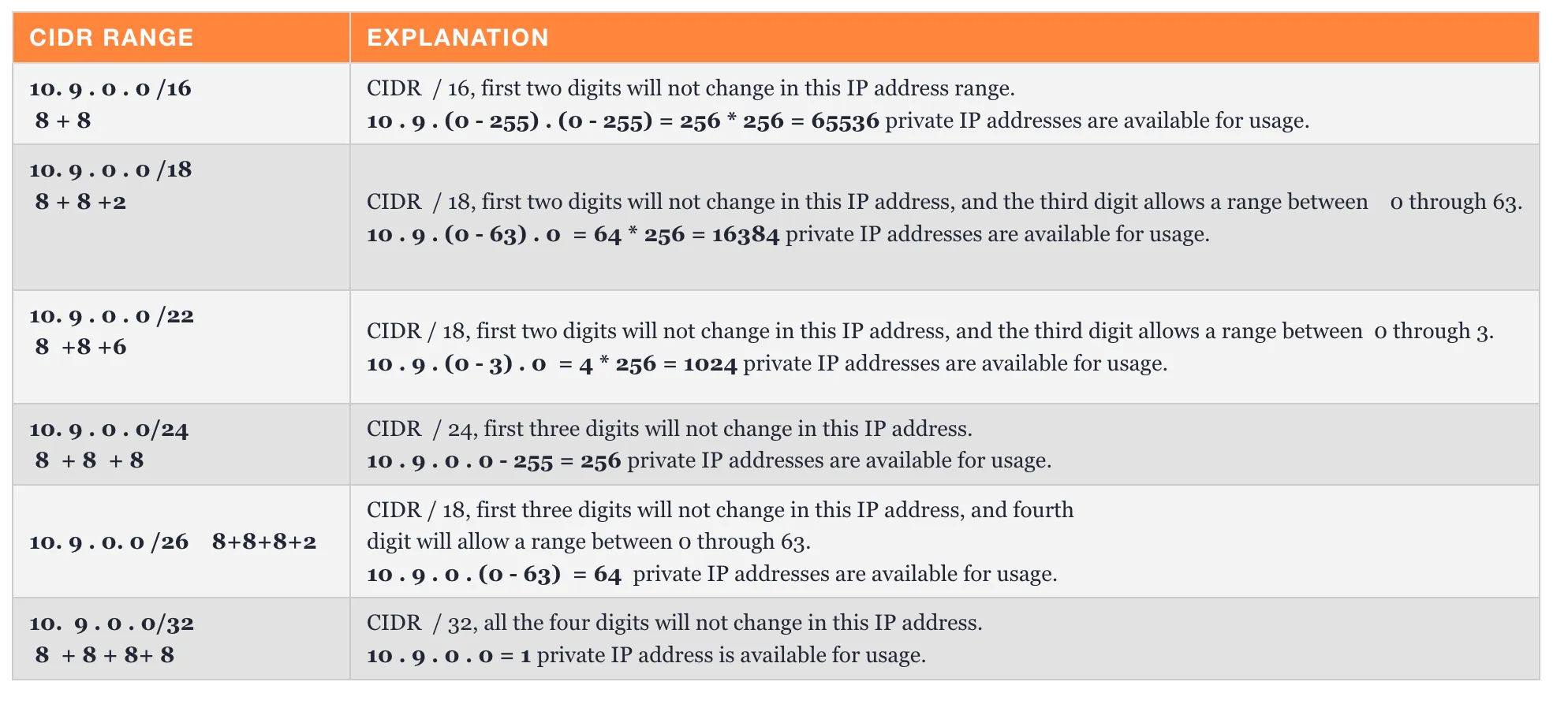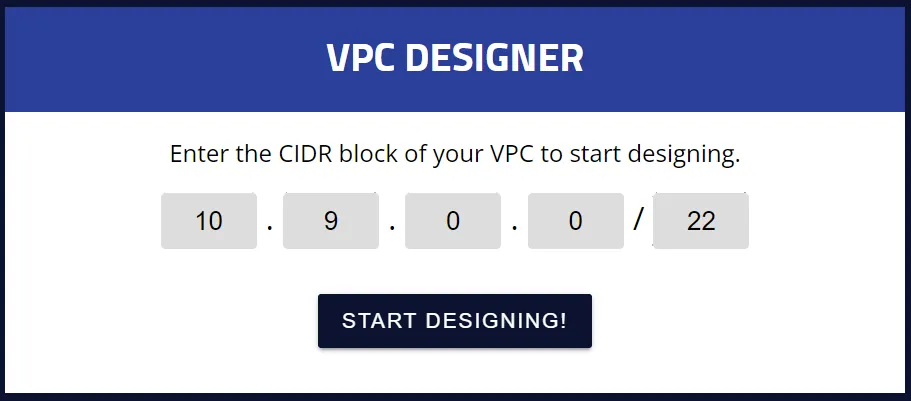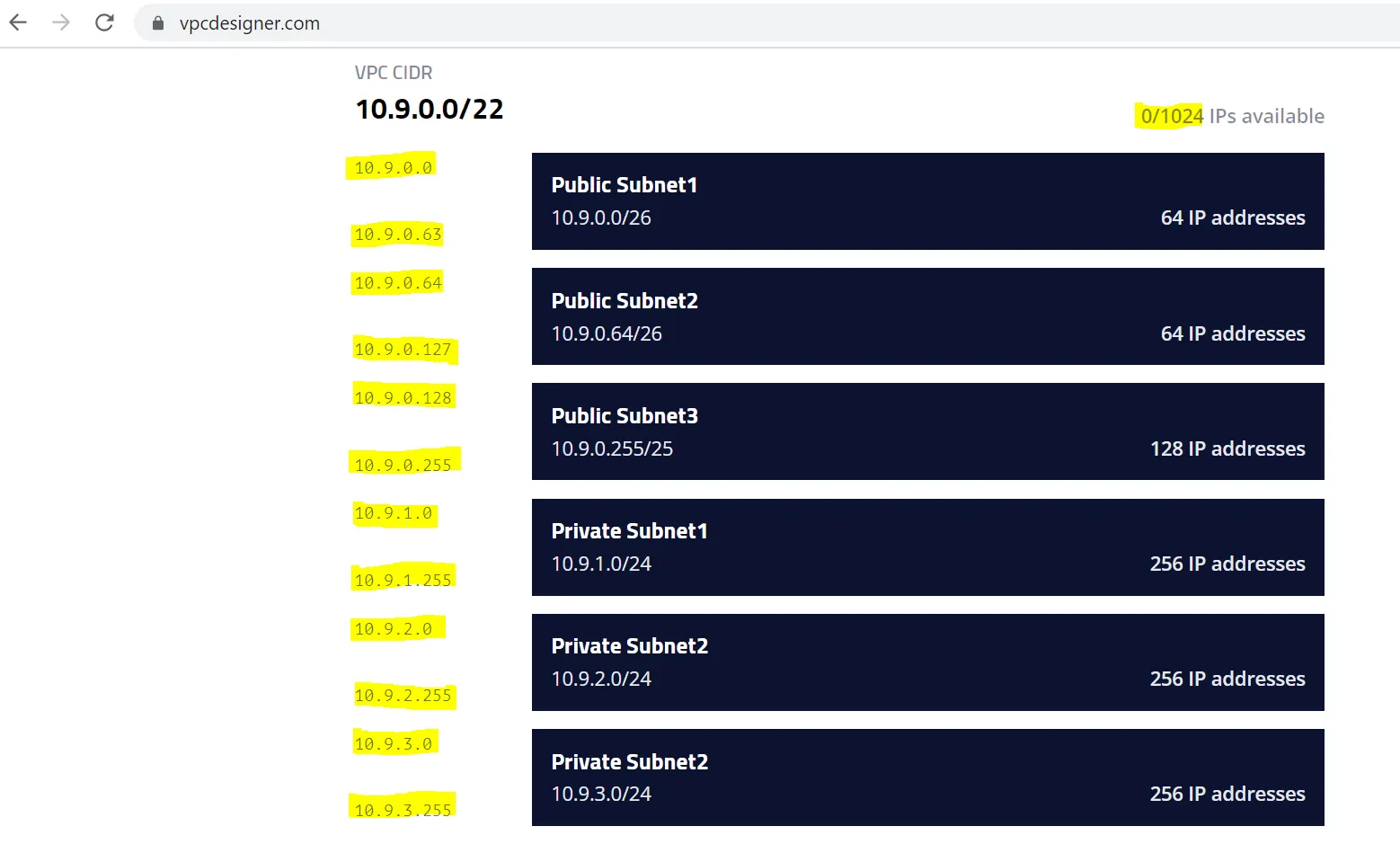Design and Create VPC in AWS
This article will help design and create Virtual Private Network using the VPC designer tool and cloud formation template. It also describes VPC components in detail.
- Isolating your own AWS resources from other AWS Accounts.
- Protecting your AWS resources deployed in VPC from network Threats.
- Routing network traffic to and from your resources deployed in VPC.

- VPC CIDR Block
- Subnets
- Security Groups
- Network Access Control Lists (ACLs)
- Gateways (Internet, NAT)
- Route Table
- An AWS account.
- AWS CLI with administrator permissions.
- Basic knowledge of CloudFormation templates.
| RFC 1918 RANGE | EXAMPLE CIDR BLOCK |
|---|---|
| 10.0.0.0 - 10.255.255.255 (10/8 prefix). | 10.0.0.0/16 |
| 172.16.0.0 - 172.31.255.255 (172.16/12 prefix) | 172.31.0.0/16 |
| 192.168.0.0 - 192.168.255.255 (192.168/16 prefix) | 192.168.0.0/20 |





1
2
3
4
5
6
7
8
9
10
11
12
13
14
15
16
17
18
19
20
21
22
23
24
25
26
27
28
29
30
31
32
33
34
35
36
37
38
39
40
41
42
43
44
45
46
47
48
49
50
51
52
53
54
55
56
57
58
59
60
61
62
63
64
65
66
67
68
69
70
71
72
73
74
75
76
77
78
79
80
81
82
83
84
85
86
87
88
89
90
91
92
93
94
95
96
97
98
99
100
101
102
103
104
105
106
107
108
109
110
111
112
113
114
115
116
117
118
119
120
121
122
123
124
125
126
127
128
129
130
131
132
133
134
135
136
137
138
139
140
141
142
143
144
145
146
147
148
149
150
151
152
153
154
155
156
157
158
159
160
161
162
163
164
165
166
167
168
169
170
171
172
173
174
175
176
177
178
179
180
181
182
183
184
185
186
187
188
189
190
191
192
193
194
195
196
197
198
199
200
201
202
203
204
205
206
207
208
209
210
211
212
213
214
215
216
217
218
219
220
221
222
223
224
225
226
227
228
229
230
231
232
233
234
235
236
237
238
239
240
241
242
243
244
245
246
247
248
249
250
251
252
253
254
255
256
257
258
259
260
261
262
263
264
265
266
267
268
269
270
271
272
273
274
275
276
277
278
279
280
281
282
283
284
285
286
287
288
289
290
291
292
293
294
295
296
297
298
299
300
301
302
303
304
305
306
307
308
309
310
311
312
313
314
315
316
317
318
319
320
321
322
323
324
325
326
327
328
329
330
331
332
333
334
335
336
337
338
339
340
341
342
343
344
345
346
347
348
349
350
351
352
353
354
355
356
357
358
359
360
361
362
363
364
365
366
367
368
AWSTemplateFormatVersion: "2010-09-09"
Description: This template deploys a VPC with a pair of public and private subnets spread across three Availability Zones. It deploys an internet gateway, defining routes to public subnets. It deploys three NAT gateways (one in each AZ), and routes them to private subnets. It also creates NACls for each Public and Private subnet.
Parameters:
pVPCCIDRBlock:
Description: Please enter the IP range for this VPC
Type: String
pPublicSubnet1CIDR:
Description: Please enter the IP range for the public subnet in the first Availability Zone
Type: String
pPublicSubnet2CIDR:
Description: Please enter the IP range for the public subnet in the second Availability Zone
Type: String
pPublicSubnet3CIDR:
Description: Please enter the IP range for the public subnet in the third Availability Zone
Type: String
pPrivateSubnet1CIDR:
Description: Please enter the IP range for the private subnet in the first Availability Zone
Type: String
pPrivateSubnet2CIDR:
Description: Please enter the IP range for the private subnet in the second Availability Zone
Type: String
pPrivateSubnet3CIDR:
Description: Please enter the IP range for the private subnet in the third Availability Zone
Type: String
Resources:
rVPC:
Type: AWS::EC2::VPC
Properties:
CidrBlock: !Ref pVPCCIDRBlock
EnableDnsSupport: true
EnableDnsHostnames: true
rPublicSubnet1:
Type: AWS::EC2::Subnet
Properties:
CidrBlock: !Ref pPublicSubnet1CIDR
VpcId: !Ref rVPC
AvailailityZone: !Select [0, !GetAZs '']
MapPublicIpOnLaunch: true
Tags:
- Key: Name
Value: "Public Subnet (AZ1)"
rPublicSubnet2:
Type: AWS::EC2::Subnet
Properties:
CidrBlock: !Ref pPublicSubnet2CIDR
VpcId: !Ref rVPC
AvailailityZone: !Select [1, !GetAZs '']
MapPublicIpOnLaunch: true
Tags:
- Key: Name
Value: "Public Subnet (AZ2)"
rPublicSubnet3:
Type: AWS::EC2::Subnet
Properties:
CidrBlock: !Ref pPublicSubnet3CIDR
VpcId: !Ref rVPC
AvailailityZone: !Select [2, !GetAZs '']
MapPublicIpOnLaunch: true
Tags:
- Key: Name
Value: "Public Subnet (AZ3)"
rPrivateSubnet1:
Type: AWS::EC2::Subnet
Properties:
CidrBlock: !Ref pPrivateSubnet1CIDR
VpcId: !Ref rVPC
AvailailityZone: !Select [0, !GetAZs '']
MapPublicIpOnLaunch: false
Tags:
- Key: Name
Value: "Private Subnet (AZ1)"
rPrivateSubnet2:
Type: AWS::EC2::Subnet
Properties:
CidrBlock: !Ref pPrivateSubnet2CIDR
VpcId: !Ref rVPC
AvailailityZone: !Select [1, !GetAZs '']
MapPublicIpOnLaunch: false
Tags:
- Key: Name
Value: "Private Subnet (AZ2)"
rPrivateSubnet3:
Type: AWS::EC2::Subnet
Properties:
CidrBlock: !Ref pPrivateSubnet3CIDR
VpcId: !Ref rVPC
AvailailityZone: !Select [2, !GetAZs '']
MapPublicIpOnLaunch: false
Tags:
- Key: Name
Value: "Private Subnet (AZ3)"
rPublicRouteTable:
Type: AWS::EC2::RouteTable
Properties:
VpcId: !Ref rVPC
Tags:
- Key: Name
Value: "Public Routes"
rPublicSubnet1RouteTableAssociation:
Type: AWS::EC2::SubnetRouteTableAssociation
Properties:
RouteTableId: !Ref rPublicRouteTable
SubnetId: !Ref rPublicSubnet1
rPublicSubnet2RouteTableAssociation:
Type: AWS::EC2::SubnetRouteTableAssociation
Properties:
RouteTableId: !Ref rPublicRouteTable
SubnetId: !Ref rPublicSubnet2
rPublicSubnet3RouteTableAssociation:
Type: AWS::EC2::SubnetRouteTableAssociation
Properties:
RouteTableId: !Ref rPublicRouteTable
SubnetId: !Ref rPublicSubnet3
rInternetGateway:
Type: AWS::EC2::InternetGateway
Properties:
Tags:
- Key: Name
Value: "Internet Gateway"
rInternetGatewayAttachment:
Type: AWS::EC2::VPCGatewayAttachment
Properties:
InternetGatewayId: !Ref rInternetGateway
VpcId: !Ref rVPC
rNatGateway1EIP:
Type: AWS::EC2::EIP
DependsOn: rInternetGatewayAttachment
Properties:
Domain: vpc
rNatGateway2EIP:
Type: AWS::EC2::EIP
DependsOn: rInternetGatewayAttachment
Properties:
Domain: vpc
rNatGateway3EIP:
Type: AWS::EC2::EIP
DependsOn: rInternetGatewayAttachment
Properties:
Domain: vpc
rNatGateway1:
Type: AWS::EC2::NatGateway
Properties:
AllocationId: !GetAtt rNatGateway1EIP.AllocationId
SubnetId: !Ref rPublicSubnet1
rNatGateway2:
Type: AWS::EC2::NatGateway
Properties:
AllocationId: !GetAtt rNatGateway2EIP.AllocationId
SubnetId: !Ref rPublicSubnet2
rNatGateway3:
Type: AWS::EC2::NatGateway
Properties:
AllocationId: !GetAtt rNatGateway3EIP.AllocationId
SubnetId: !Ref rPublicSubnet3
rPrivateRouteTable1:
Type: AWS::EC2::RouteTable
Properties:
VpcId: !Ref rVPC
Tags:
- Key: Name
Value: "Private Routes (AZ1)"
rPrivateRouteTable2:
Type: AWS::EC2::RouteTable
Properties:
VpcId: !Ref rVPC
Tags:
- Key: Name
Value: "Private Routes (AZ2)"
rPrivateRouteTable3:
Type: AWS::EC2::RouteTable
Properties:
VpcId: !Ref rVPC
Tags:
- Key: Name
Value: "Private Routes (AZ3)"
rPrivateSubnet1RouteTableAssociation:
Type: AWS::EC2::SubnetRouteTableAssociation
Properties:
RouteTableId: !Ref rPrivateRouteTable1
SubnetId: !Ref rPrivateSubnet1
rPrivateSubnet2RouteTableAssociation:
Type: AWS::EC2::SubnetRouteTableAssociation
Properties:
RouteTableId: !Ref rPrivateRouteTable2
SubnetId: !Ref rPrivateSubnet2
rPrivateSubnet3RouteTableAssociation:
Type: AWS::EC2::SubnetRouteTableAssociation
Properties:
RouteTableId: !Ref rPrivateRouteTable3
SubnetId: !Ref rPrivateSubnet3
rPublicDefaultRoute:
Type: AWS::EC2::Route
Properties:
RouteTableId: !Ref rPublicRouteTable
DestinationCidrBlock: 0.0.0.0/0
GatewayId: !Ref rInternetGateway
rPriaveteNATGatewayRoute1:
Type: AWS::EC2::Route
Properties:
RouteTableId: !Ref rPrivateRouteTable1
NatGatewayId: rNatGateway1
DestinationCidrBlock: 0.0.0.0/0
rPriaveteNATGatewayRoute2:
Type: AWS::EC2::Route
Properties:
RouteTableId: !Ref rPrivateRouteTable2
NatGatewayId: rNatGateway2
DestinationCidrBlock: 0.0.0.0/0
rPriaveteNATGatewayRoute3:
Type: AWS::EC2::Route
Properties:
RouteTableId: !Ref rPrivateRouteTable3
NatGatewayId: rNatGateway2
DestinationCidrBlock: 0.0.0.0/0
rPublicSubnetNacl:
Type: AWS::EC2::NetworkAcl
Properties:
VpcId: !Ref rVPC
Tags:
- Key: Name
Value: "Public Subnet Nacl"
rPrivateSubnetNacl:
Type: AWS::EC2::NetworkAcl
Properties:
VpcId: !Ref rVPC
Tags:
- Key: Name
Value: "Private Subnet Nacl"
rPublicSubnetInbound:
Type: AWS::EC2::NetworkAclEntry
Properties:
NetworkAclId: !Ref rPublicSubnetNacl
Egress: false
RuleNumber: 10
Protocol: 6
RuleAction: 'allow'
CidrBlock: '0.0.0.0/0'
PortRange:
From: 1024
To: 65535
rPublicSubnetOutbound:
Type: AWS::EC2::NetworkAclEntry
Properties:
NetworkAclId: !Ref rPublicSubnetNacl
Egress: true
RuleNumber: 10
Protocol: -1
RuleAction: 'allow'
CidrBlock: '0.0.0.0/0'
PortRange:
From: 22
To: 65535
rPublicSubnetInbound:
Type: AWS::EC2::NetworkAclEntry
Properties:
NetworkAclId: !Ref rPrivateSubnetNacl
Egress: false
RuleNumber: 10
Protocol: -1
RuleAction: 'deny'
CidrBlock: '0.0.0.0/0'
PortRange:
From: 1024
To: 65535
rPublicSubnetOutbound:
Type: AWS::EC2::NetworkAclEntry
Properties:
NetworkAclId: !Ref rPrivateSubnetNacl
Egress: true
RuleNumber: 10
Protocol: 6
RuleAction: 'allow'
CidrBlock: '0.0.0.0/0'
PortRange:
From: 1024
To: 65535
rNaclPublicSubnetAssociation1:
Type: AWS::EC2::SubnetNetworkAclAssociation
Properties:
NetworkAclId: !Ref rPublicSubnetNacl
Subnet: !Ref rPublicSubnet1
rNaclPublicSubnetAssociation2:
Type: AWS::EC2::SubnetNetworkAclAssociation
Properties:
NetworkAclId: !Ref rPublicSubnetNacl
Subnet: !Ref rPublicSubnet2
rNaclPublicSubnetAssociation3:
Type: AWS::EC2::SubnetNetworkAclAssociation
Properties:
NetworkAclId: !Ref rPublicSubnetNacl
Subnet: !Ref rPublicSubnet3
rNaclPrivateSubnetAssociation1:
Type: AWS::EC2::SubnetNetworkAclAssociation
Properties:
NetworkAclId: !Ref rPrivateSubnetNacl
Subnet: !Ref rPublicSubnet1
rNaclPrivateSubnetAssociation2:
Type: AWS::EC2::SubnetNetworkAclAssociation
Properties:
NetworkAclId: !Ref rPrivateSubnetNacl
Subnet: !Ref rPrivateSubnet2
rNaclPrivateSubnetAssociation3:
Type: AWS::EC2::SubnetNetworkAclAssociation
Properties:
NetworkAclId: !Ref rPublicSubnetNacl
Subnet: !Ref rPrivateSubnet3
Outputs:
VPC:
Description: "VPC Id"
Value: !Ref VPC
PublicSubnets:
Description: "Public subnets"
Value: !Join [ ",", [ !Ref rPublicSubnet1, !Ref rPublicSubnet2, !Ref rPublicSubnet3 ]]
PrivateSubnets:
Description: "Private subnets"
Value: !Join [ ",", [ !Ref rPrivateSubnet1, !Ref rPrivateSubnet2, !Ref rPrivateSubnet3]]



